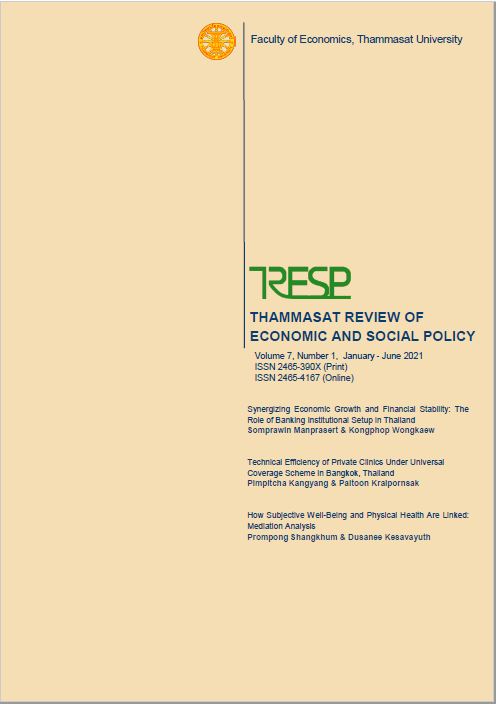Synergizing Economic Growth and Financial Stability: The Role of Banking Institutional Setup in Thailand
Keywords:
Economic Growth, Financial Stability, Credit, Banks, New Institutional EconomicsAbstract
The Thai banking system has contributed less to economic growth and has become more detached from the real economy in recent years. We find that Thailand's bank credit market has been distorted, with banks providing restricted corporate credit for new establishments and investments, particularly for SMEs. This article discusses the underlying reasons for low corporate lending and a distorted credit market. We demonstrate that the Thai corporate credit market has been constrained by inadequate credit supply for more than threefourths
of the time between 2010 and the third quarter of 2020. Additionally, we find that loan approval decisions have been substantially weighted toward risk. Then, we examine the link between credit inclusion and credit risk, highlighting the opportunity for the Thai banking system to benefit from the synergy between credit inclusion and risk management. The result implies that the Thai banking system should put more emphasis on credit inclusion. Finally, we seek to give remedies via the lens of new institutional economics from a historical viewpoint. That is, the regulator must prevent overprotection and encourage more competition within the banking industry.
References
Bertrand, M., Schoar, A., & Thesmar, D. (2007). Banking Deregulation and Industry Structure: Evidence from the French Banking Reforms of 1985. The Journal of Finance, 62(2), 597-628.
Claessens, S. (2006). Access to financial services: a review of the issues and public policy objectives. Journal of
Financial Transformation, 17, 16-19.
Hannig, A., & Jansen, S. (2010). Financial Inclusion and Financial Stability: Current Policy Issues, SSRN Electronic Journal.
Heffernan, S. (2005). Modern Banking. John Wiley & Sons, Ltd.
Jiménez G., Ongena S., Peydró, J-L. & Saurina, J. (2012). Credit Supply and Monetary Policy: Identifying the Bank Balance-Sheet Channel with Loan Applications. American Economic Review, 102(5), 2301-2326.
Kishan, R. P., & Opiela, T. (2000). Bank Size, Bank Capital, and the Bank Lending Channel. Journal of Money, Credit and Banking. 32(1), 121-41.
Maddala, G. S. & Nelson, F. D. (1974). Maximum Likelihood Methods for Models of Markets in Disequilibrium. Econometrica, 42(6), 1013-1030.
Mehrotra, A., & Yetman, J. (2014). Financial inclusion and optimal monetary policy (No. 476). Bank for International Settlements.
Morgan, P., & Pontines, V. (2014). Financial Stability and Financial Inclusion. SSRN Electronic Journal.
Shekhar, K. C., & Shekhar, L. (2013). Banking Theory and Practice, 21st Edition. Vikas Publishing House.



